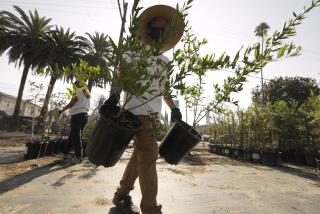California’s heat wave is making lemons far more expensive

The lemon slice for your iced tea is set to get more expensive, and you can blame California’s scorching weather for that.
The hot conditions that helped spark deadly wildfires in California also are taking a toll on the state’s citrus crop. Although groves have largely been spared from the blazes, the sweltering heat is causing lemons to ripen prematurely, analysts at Stifel Financial Corp., including Vincent Anderson, said in a report this week. That has sent prices surging by as much as 49% from a month ago.
The crop threat comes at a time when demand was already projected to outpace domestic production for at least the seventh straight year. Americans’ zest for lemons — also used as garnish when drinking tequila or to make lemonade, marmalade and salad dressing — has soared thanks to more consumer demand for fresh ingredients. The heat wave in California, the top U.S. grower, probably will further widen the gap between output and use.
In the year that will end Sept. 30, the United States is forecast to produce 791,070 metric tons of lemons, with demand estimated at 1.247 million, spurring the most imports since at least the 2013-2014 growing season, government data showed last month.
As the U.S. crop suffers, global production woes also are making supplies harder to get. That’s partly because of weather problems reducing output in Mexico — a major exporter to the United States — by as much as 20% from a year ago, Stifel said. Issues with Spain’s harvest and a lack of “significant” Argentine shipments “have only compounded the shortfall,” the analysts said.
“The result has been a spike in prices across the size and quality spectrum,” Stifel said. Small, so-called fancy lemons, considered a more premium product, are up 34% compared with a month ago, and the price of large so-called choice lemons jumped 49%, the analysts said in the Aug. 7 note, citing government data. In California, “we expect the heat wave to affect all lemon growers relatively equally, compared to droughts where farmers with advantaged water rights hold an edge,” they said.
By October or November, the domestic crop will be ready to harvest, and supply will get some support before the end of the year, said David Magaña, a senior horticulture analyst at Rabobank in Fresno. But for the next two months, he expects the shortage that began in May and June to continue.
Some relief eventually could come as suppliers plant more trees to meet rising demand. Limoneira Co. — based in the Ventura County city of Santa Paula — has about 8,200 acres of lemon groves and plans to add an additional 500 over the next two years, the company said on a June 11 call to discuss earnings. Shares of Limoneira have jumped more than 18% since July 1 as the fruit price soared.
Still, it’s going to be quite some time before that acreage bears lemons ready for the market. It takes roughly four years for new trees to start producing fruit, and yields don’t reach mature production until the fifth or sixth year, according to Rabobank.
Meanwhile, consumption is likely to stay robust.
At New York restaurant Fig & Olive, general manager Ray Tabares estimates the Mediterranean eatery uses about 20 pounds of lemons a week at its Lexington Avenue location. That’s up as much as 20% from a year ago because customers are ordering more fresh drinks like iced tea and lemonade, rather than sodas, he said. More lemons also are being used for avocado toast.
“About six years ago, we noticed a marked trend away from processed products to fresh utilization of lemons,” Joel Nelsen, the president of California Citrus Mutual in Exeter, Calif., said by email. “Whereas 60% plus of the lemon crop used to go to fragrances and concentrate-type uses, more of it is being sold fresh as restaurants and consumers use more lemons for meals and lemonade purposes. Quite a boom.”
Perez and Vasquez write for Bloomberg.






